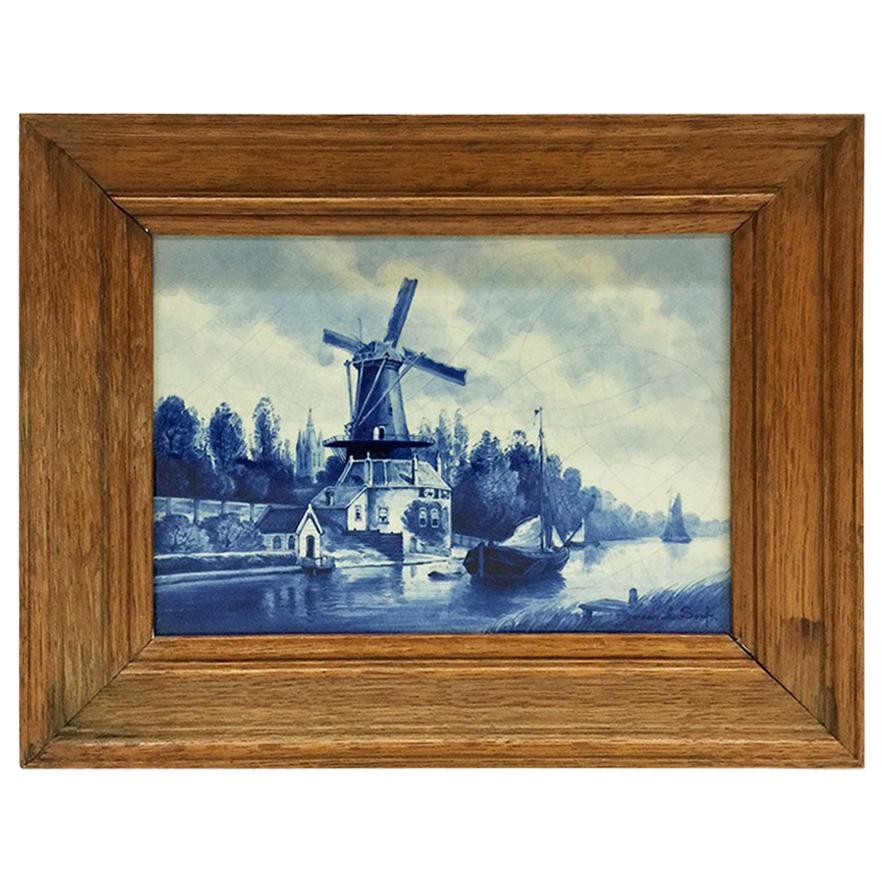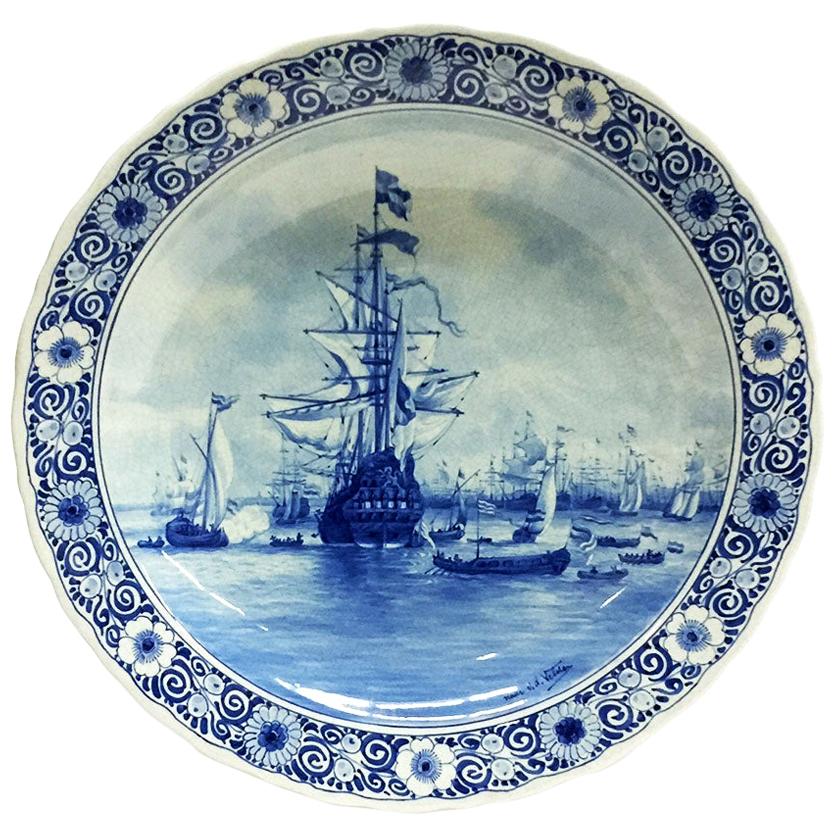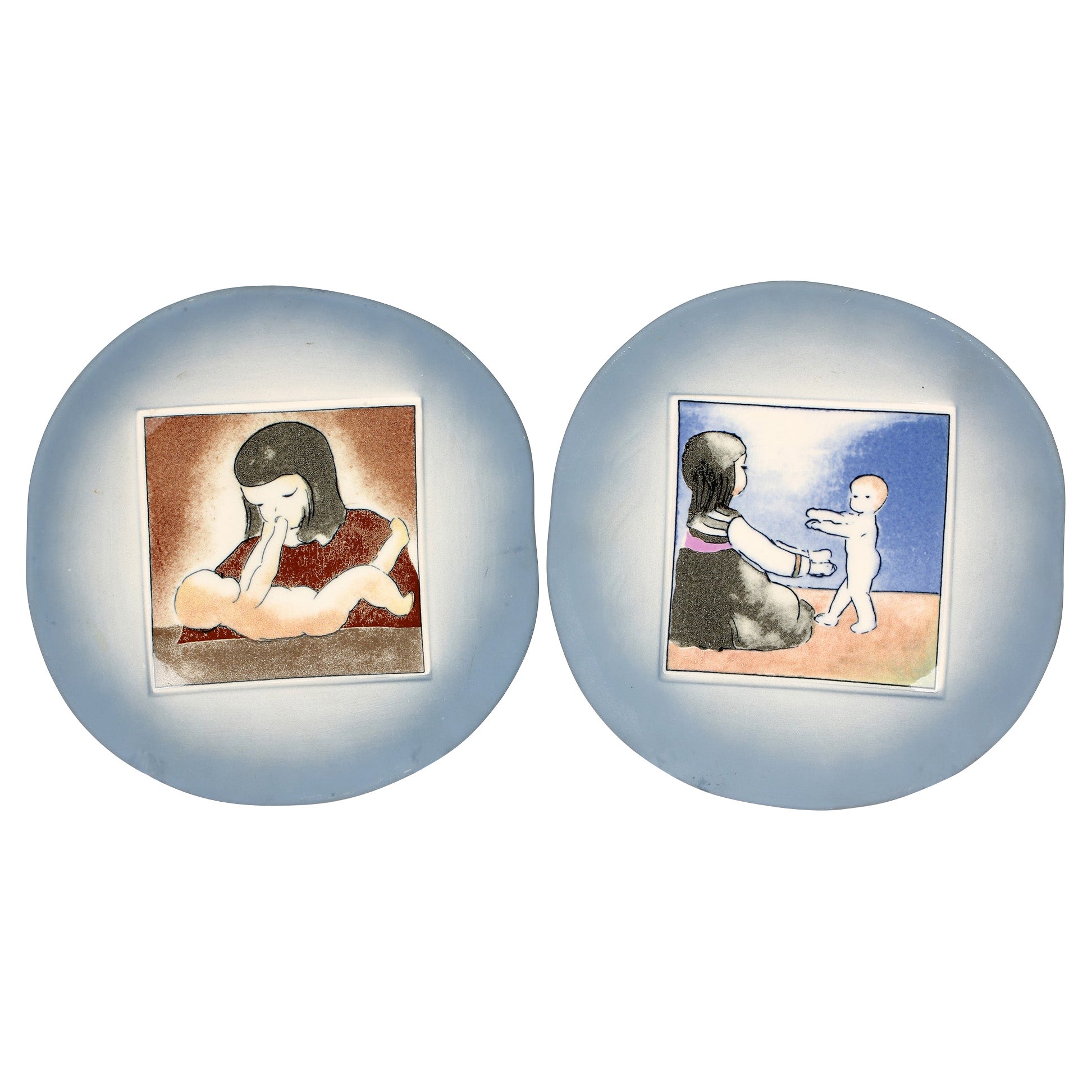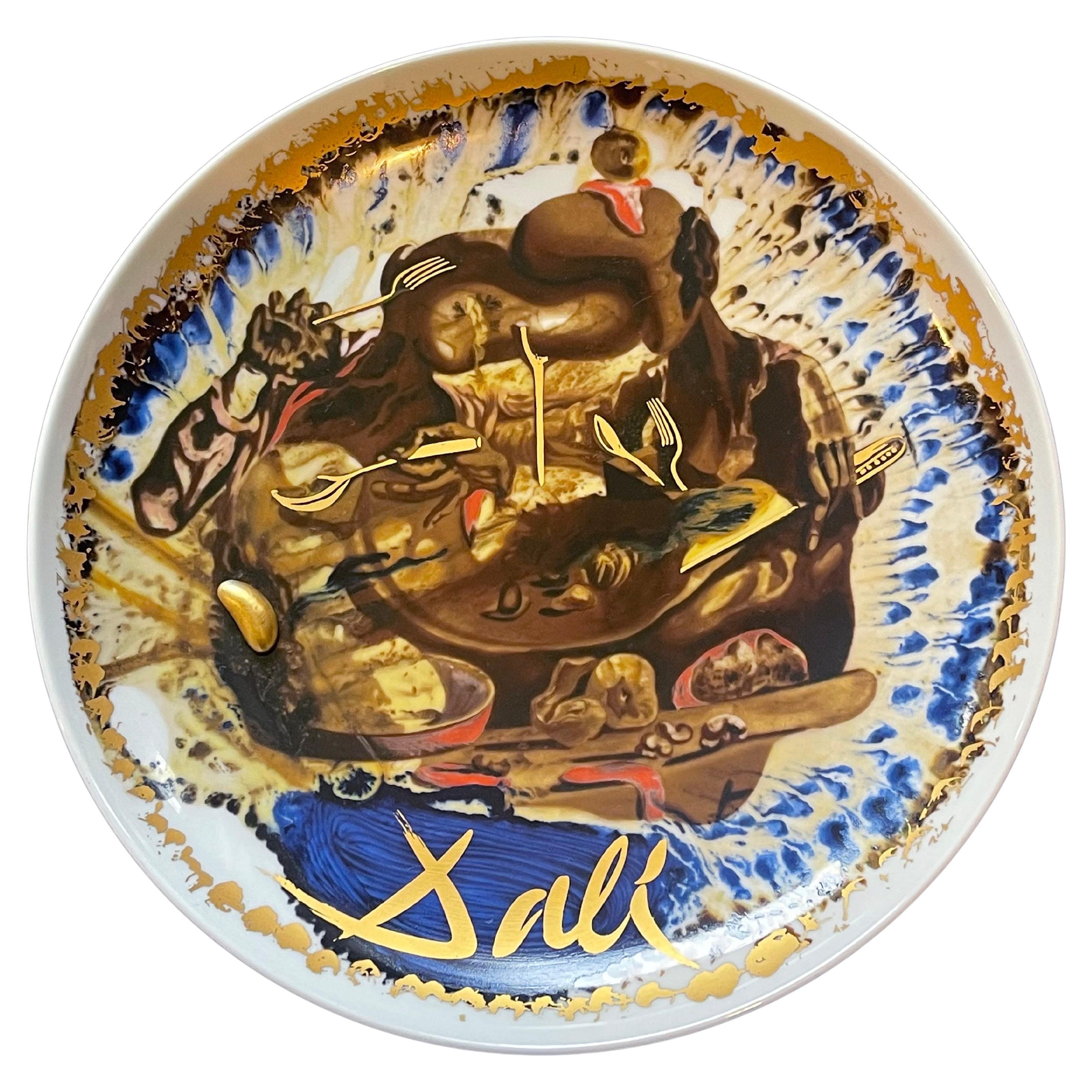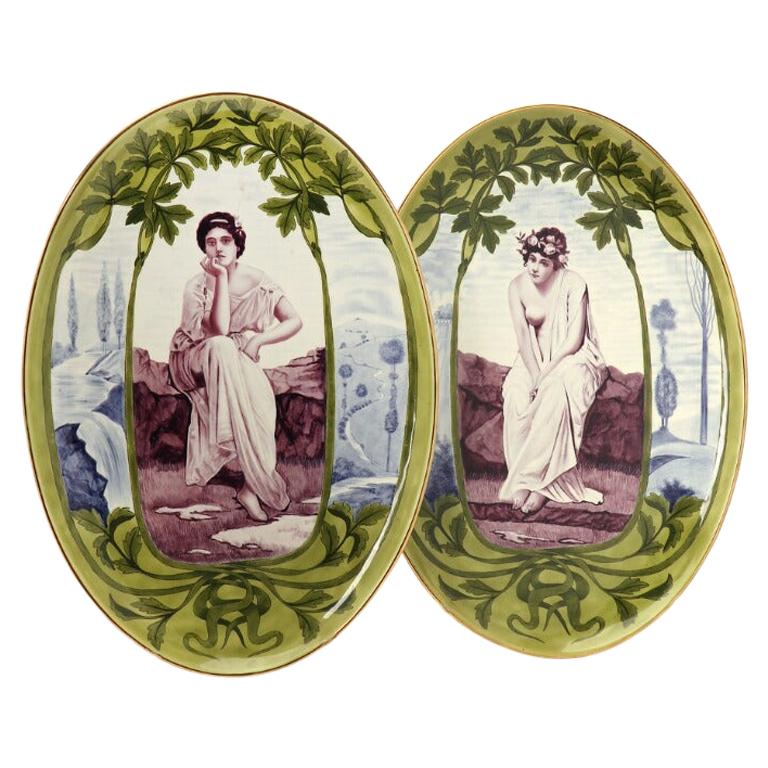Gianni Versace "le Voyage de Marco Polo" for Rosenthal
About the Item
- Creator:Gianni Versace (Designer)
- Dimensions:Height: 0.5 in (1.27 cm)Diameter: 12 in (30.48 cm)
- Style:Baroque (In the Style Of)
- Materials and Techniques:
- Place of Origin:
- Period:
- Date of Manufacture:1990
- Condition:Wear consistent with age and use.
- Seller Location:North Hollywood, CA
- Reference Number:
Gianni Versace
The signature extravagance of legendary fashion designer Gianni Versace — forever aligned with glamour, sex, celebrity and spectacle — can overshadow the Italian couturier’s broad and deep engagement with history and culture. More than any designer before him, Versace mined celebrity, music and Pop art for inspiration, and his subversive, maximalist and unabashedly seductive designs infused high fashion with an entirely new ethos.
“I don’t believe in good taste,” Versace once explained. Instead, he had a sexy good time with fashion — as he did with life. Today, vintage Gianni Versace clothing, handbags and other accessories look astonishingly fresh and freshly relevant.
Gianni Versace was born in Calabria, Italy. His mother was a successful dressmaker who employed more than 40 seamstresses. As a child, little Gianni marveled at her workshop, which would become a university of sorts, where he learned the exceptional construction techniques that were at the foundation of his creative expression. In 1972, at age 25, he moved to Milan to work in fashion. He launched his first collection — and his label — in 1978, with his older brother Santo managing the business concerns. Soon, sister Donatella, whom Gianni dressed and took to discos when she was still a child, joined the family venture, where she had a creative role and managed enormously popular ready-to-wear lines such as Versus.
Vintage Versace has become catnip for modern fashion enthusiasts who seek out the now-iconic house codes that originated in the designs of the 1980s and 1990s. His glamorous and seductive apparel — the clingy skirts and slender, strappy party dresses, as well as the erotic magazine ads that publicized them — looms large, but Versace’s art and historical influences were also vast.
Versace was an art collector, and he took on commissions to create costumes for theatrical performances during the 1980s and spoke of looking to numerous cultures for inspiration. The New York Times noted in 1997 that the fashion industry “is now driven by contemporary culture because Mr. Versace made it that way.” Insiders consider his 1991/1992 Autumn/Winter runway show — which featured supermodels Christy Turlington, Cindy Crawford, Naomi Campbell and Linda Evangelista lip-synching George Michael’s “Freedom” — as the moment when the two worlds of fashion and pop culture became one, changing both forever.
Versace's adventurous spirit of design resulted in his creating jewel-toned prints rooted in Grecian motifs, Etruscan symbols, the Italian Baroque and Andy Warholʼs Marilyn Monroe. There were slinky dresses in Oroton, his patented chain-mail textile that draped like satin, and leather bondage ensembles. Sex sold, for both women and men. Wrote the late curator Richard Martin, “[Versace] became the standard-bearer of gay men’s fashion because he eschewed decorum and designed for desire.”
Following Versace’s tragic murder in 1997, Donatella took over the role of artistic director and continued to evolve the house codes with a twist of her feminine and feminist perspective. Today, Santo Versace is chief executive officer of Versace and Donatella is its chief creative officer.
Browse an extraordinary collection of vintage Gianni Versace evening dresses, handbags, day dresses and more on 1stDibs.
- ShippingRetrieving quote...Ships From: North Hollywood, CA
- Return PolicyA return for this item may be initiated within 7 days of delivery.
- Vintage Collectible Villeroy and Boch Porcelain Plate 1900 Art Deco DesignBy Villeroy & BochLocated in North Hollywood, CAVintage Villeroy and Boch China 1900 Art Deco design. Collectible Villeroy & Boch Plates design 1900, Villeroy & Boch Design 1900 Porcelain...Category
Late 20th Century Luxembourgish Art Deco Decorative Art
MaterialsPorcelain
- Art Deco Design Porcelain Plate Vintage Collectible Villeroy and Boch 1900By Villeroy & BochLocated in North Hollywood, CAVintage Villeroy and Boch 1900 Art Deco design, woman with parrot. Villeroy & Boch Design 1900 Porcelain collectible plate. The subjects co...Category
Late 20th Century Luxembourgish Art Deco Decorative Art
MaterialsPorcelain
- Rosenthal Collectible Framed Plates, Set of 3By RosenthalLocated in North Hollywood, CARosenthal collectible, set of three framed German plates. One by Vasarely, 1936. "Leben und Leben lassen, Liben und Lieben lassen" Limited edition, s...Category
Vintage 1980s German Modern Contemporary Art
MaterialsPorcelain
- JAMES RIZZI "City People" Rosenthal Germany Collectible Plate Limited EditionLocated in North Hollywood, CAJAMES RIZZI "City People" Rosenthal Germany Collectible Plate Limited Edition. 1970s Rosenthal collectible porcelain plate 'City People', designed by James Rizzi, Executed by Rosenthal, Germany, limited edition, no./1500 Limited edition, signed and numbered. Framed plate is in excellent condition, plate size is 12". Frames is not in good condition, white became yellowish shows wear. About James Rizzi: AMERICAN, 1950-2011 James Rizzi (October 5, 1950 – December 26, 2011) was an American pop artist who was born and raised in Brooklyn, New York. Best known for his vibrant, youthful graphics and his three-dimensional prints. He was the official artist for the 1996 Olympic Games in Atlanta, adorning the famous logo with his noodle-like drawing style. Rizzi was most famous for his 3D artwork, "especially the large, elaborate prints and teeming anthropomorphic cityscapes. His merry maximalism and delight in delirious detail and elaborate minutiae created a true art brand, a trademark style as recognizable as any in the world." About Rosenthal: German porcelain manufactory Rosenthal was originally founded as a ceramics-painting studio by Philipp Rosenthal Sr. (1855-1937) in 1879 at Schloss Erkersreuth in Bavaria, near the Czech border. Its first highly popular product was an ashtray inscribed with the words “Resting place for lit cigars.” In 1890, the company moved to the neighboring hamlet of Selb and, a year later, began to manufacture its own porcelain, since white porcelain was, at that time, in short supply. Rosenthal’s first complete table service was called Empire; it was exhibited along with other lines at Paris’s Exposition Universelle in 1900. With the dawn of the 20th century, Rosenthal began producing porcelain tableware and services formed and decorated in the latest styles, like the Jugendstil Botticelli (1903), the Art Nouveau Darmstadt (1905), and the all-white Maria (1916) lines. Successes with this au courant approach led the company to launch an art pottery division in 1910, dedicated to luxury tableware, vases, and other decorative objects. By the 1930s, figurines were another important Rosenthal product, most notably the Disney-licensed Mickey Mouse pieces introduced in 1931. In 1934, Philipp Rosenthal was forced to leave his company and country when his Jewish ancestry came under persecution by the Nazi regime. Despite the loss of its founder, the Rosenthal company remained the premier supplier of high-quality porcelain tableware to the Third Reich. After the war, in 1950, Philip Rosenthal Jr. (1916-2001) joined his father's company as an advertising manager. By 1958, he had become its CEO, continuing his father’s vision to produce high-quality porcelain in line with progressive tastes. Through the rest of the 20th century, Rosenthal was the most commercially successful porcelain producer in Germany. In the postwar era, Rosenthal’s most famous tableware lines have included 2000 by Raymond Loewy and Richard Latham (1954), Magic Flute by Bjørn Wiinblad (1959), Suomi by Timo Sarpaneva (1976), and Moon by Jasper Morrison (1997). The company has enjoyed many popular and critically acclaimed collaborations with designers and brands, like Salvador Dalì, Tapio Wirkkala, Walter Gropius, Andy Warhol, Ron Arad, Enzo Mari, Konstantin Grcic, and Versace. Rosenthal's product lines have encompassed more than ceramics over the years. In 1972, the company began producing furniture, under the subsidiary Rosenthal Einrichtung, in Espelkamp, Germany. Standouts from this arm of Rosenthal include Gunter Ferdinand Ris and Herbert Selldorf’s futuristic Sunball Lounge Chair (1969), Verner Panton’s Relaxer Rocking Chair (1974), Burchard Vogtherr's Vario Pillo...Category
Late 20th Century American Expressionist Decorative Art
MaterialsPorcelain
- Bjorn Wiinblad ALADIN in the Enchanted Garden Porcelain Plate by RosenthalBy Rosenthal, Bjorn WiinbladLocated in North Hollywood, CABjørn Wiinblad wall Plate, produced by Rosenthal. ALADIN in the Enchanted Garden #4 Wall Plate Bjorn Wiinblad Rosenthal. Vintage porcelain collector plate by Rosenthal Studio Line, Germany from the series " Aladin im Zubergarten" plate "Aladin und die Wunderlampe IV". This decorative wall plate is titled "Aladin im Zaubergarten eingesperrt" (Aladin in the Enchanted Garden) and is number 4 in the collectible series of 12. The plate includes hanging hardware affixed to the back, shown. The various colors, together with the gold, make these plates true and precious collector's items. Bjørn Wiinblad porcelain Rosenthal Studio Line Collectable Plate. In pristine condition. Dimensions: 6.25 in. diameter. Artist: Bjørn Wiinblad. Plate Number: 4 (series of 12) Title: Aladin in the Enchanted Garden Hardware: Fixed, hanging. Aladdin and the Magic Lamp series was designed in the 60s by the Danish artist and chief designer of Rosenthal, Björn Wiinblad. Connoisseurs of Wiinblad's work know that this great artist worked in various industries and fields in the 20th century and had his works in renowned museums such as the Victoria and Albert Museum in London, the Museum of Modern Art in New York, the National Museum in Sweden, were collected from the Moderna Museet in Copenhagen and today have a high collector's value. Rosenthal is a German company that is well-known for its production of high-quality porcelain and other luxury goods. The company has a long history, dating back to the late 19th century, and it has collaborated with various artists and designers over the years to create unique and artistic pieces. This Bjorn Wiinblad Vintage Danish Modern Rosenthal porcelain " Aladdin " collector's decorative plate is a very special and unique piece to add to your collection. The porcelain collector's decorative wall plate is made by Rosenthal Studio Line, Germany from 1976 - 1982. Made of fine porcelain, the round decorative plate features a beautiful multicolor design of Aladdin with special metallic gold details. It is signed in the plate lower front and has an attached hanger on the reverse back side for easy wall installation. Characteristics of Wiinblad's work include whimsical round faced people, dressed vaguely in 19th Century costume. They are often surrounded by natural elements : twining vines, floral wreathes, and fantastical trees. When Wiinblad employed color, he did so with great assurance. His color palette is saturated and strong, often accented with metallic gold or silver. Bjørn Wiinblad was a Danish painter, designer, and artist known for his distinctive and whimsical style. He gained international recognition for his work, which often featured imaginative and decorative elements. Wiinblad was active from the mid-20th century until his passing in 2006. Bjorn Wiinblad ( 1918 - 2006 ) was a Danish painter, designer, and artist known for his distinctive and whimsical style in ceramics, silver, bronze, textiles, and graphics. He gained international recognition for his work, which often featured imaginative and decorative elements. His artworks have been exhibited internationally since the early 1950's. Wiinblad was named Man...Category
Mid-20th Century German Expressionist Decorative Art
MaterialsPorcelain
- 1970s VASARELY "Live and let live love and let love" Rosenthal Framed PlateBy Victor Vasarely, RosenthalLocated in North Hollywood, CA1970s VICTOR VASARELY "Live and let live love and let love". Rosenthal collectible framed German plate. Victor Vasarely Rosenthal Studio Line Limited Edition Porcelain Plate. By Vasarely born 1936. "Leben und Leben lassen, Lieben und Lieben lassen" "Live and let live - love and let love". Limited edition, signed and numbered. Plate is in good condition, size is 12". Frame is not in good condition, white became yellowish shows wear. Victor Vasarely, born as Győző Vásárhelyi on April 9, 1906, in Pécs, Hungary, was a Hungarian-French artist widely regarded as the "father of Op Art" (Optical Art). He is known for his pioneering work in geometric abstraction and the use of optical illusions to create visually captivating and dynamic artworks. Vasarely's early career involved studying medicine in Budapest, but he later decided to pursue his passion for art and enrolled in the Műhely (Workshop) academy in Hungary. He initially experimented with various styles, including Impressionism and Post-Impressionism, but his interest in geometric abstraction grew stronger over time. In the 1930s, Vasarely moved to Paris, where he continued to explore geometric patterns, lines, and shapes in his art. He believed that art should not merely imitate nature but should create its own language of forms and colors to engage the viewer's perception actively. This philosophy led to the development of Op Art, a movement that emerged in the 1960s and focused on creating optical illusions and visual effects through precise geometric patterns and colors. Vasarely's artworks often featured meticulously arranged geometric shapes, giving the impression of movement and three-dimensionality. He employed various optical tricks, such as the juxtaposition of contrasting colors and the use of repetition, to create an illusion of depth and visual dynamism. His artworks can evoke a sense of visual vibration and often challenge the viewer's perception. Throughout his career, Vasarely's influence extended beyond the art world. He believed in the democratization of art and wanted to make art accessible to a wider audience. He embraced mass production techniques, creating what he called "multiple originals" or "serigraphs" (a form of screen printing). These serigraphs allowed him to produce multiple copies of his artworks at affordable prices, making them more accessible to art enthusiasts. Vasarely's artistic legacy continues to be celebrated around the world. His work has been exhibited in numerous galleries and museums, and he remains an influential figure in the fields of Op Art and abstract geometric art. He passed away on March 15, 1997, in Paris, leaving behind a vast body of work that continues to captivate audiences and inspire artists to this day. About Rosenthal: German porcelain manufactory Rosenthal was originally founded as a ceramics-painting studio by Philipp Rosenthal Sr. (1855-1937) in 1879 at Schloss Erkersreuth in Bavaria, near the Czech border. Its first highly popular product was an ashtray inscribed with the words “Resting place for lit cigars.” In 1890, the company moved to the neighboring hamlet of Selb and, a year later, began to manufacture its own porcelain, since white porcelain was, at that time, in short supply. Rosenthal’s first complete table service was called Empire; it was exhibited along with other lines at Paris’s Exposition Universelle in 1900. With the dawn of the 20th century, Rosenthal began producing porcelain tableware and services formed and decorated in the latest styles, like the Jugendstil Botticelli (1903), the Art Nouveau Darmstadt (1905), and the all-white Maria (1916) lines. Successes with this au courant approach led the company to launch an art pottery division in 1910, dedicated to luxury tableware, vases, and other decorative objects. By the 1930s, figurines were another important Rosenthal product, most notably the Disney-licensed Mickey Mouse pieces introduced in 1931. In 1934, Philipp Rosenthal was forced to leave his company and country when his Jewish ancestry came under persecution by the Nazi regime. Despite the loss of its founder, the Rosenthal company remained the premier supplier of high-quality porcelain tableware to the Third Reich. After the war, in 1950, Philip Rosenthal Jr. (1916-2001) joined his father's company as an advertising manager. By 1958, he had become its CEO, continuing his father’s vision to produce high-quality porcelain in line with progressive tastes. Through the rest of the 20th century, Rosenthal was the most commercially successful porcelain producer in Germany. In the postwar era, Rosenthal’s most famous tableware lines have included 2000 by Raymond Loewy and Richard Latham (1954), Magic Flute by Bjørn Wiinblad (1959), Suomi by Timo Sarpaneva (1976), and Moon by Jasper Morrison (1997). The company has enjoyed many popular and critically acclaimed collaborations with designers and brands, like Salvador Dalì, Tapio Wirkkala, Walter Gropius, Andy Warhol, Ron Arad, Enzo Mari, Konstantin Grcic, and Versace. Rosenthal's product lines have encompassed more than ceramics over the years. In 1972, the company began producing furniture, under the subsidiary Rosenthal Einrichtung, in Espelkamp, Germany. Standouts from this arm of Rosenthal include Gunter Ferdinand Ris and Herbert Selldorf’s futuristic Sunball Lounge Chair (1969), Verner Panton’s Relaxer Rocking Chair (1974), Burchard Vogtherr's Vario Pillo...Category
Late 20th Century German Post-Modern Decorative Art
MaterialsPorcelain
- Dutch Delft Porceleyne Fles tile Delft, Mill "De Roos", after L. Senf, 1906By De Koninklijke Porceleyne FlesLocated in Delft, NLA Dutch delft Porceleyne Fles tile delft , Mill "De Roos" , after L. Senf, 1906 A delft Porceleyne Fles tile of 15 cm high, 21 cm wide in a wooden frame. Image represents the Mi...Category
20th Century Dutch Decorative Art
MaterialsPorcelain, Wood
- Wall Plate by Delft Porceleyne Fles, After a Painting by Van de Velde, 1898By De Koninklijke Porceleyne FlesLocated in Delft, NLA wall plate by Delft Porceleyne Fles, after a painting by Willem van de Velde (de Jonge) 1633-1707 A wall plate by Delft Porceleyne Fles with a diameter o...Category
Antique 19th Century Dutch Decorative Art
MaterialsEarthenware
- Bertil Lundgren for Rörstrand, "Gallery 1" Wall Plaque in Glazed PorcelainLocated in Copenhagen, DKBertil Lundgren for Rörstrand. "Gallery 1" wall plaque in glazed porcelain with fish. 1970s. Measures: 25 x 25 cm. In excellent condition. Stamped.Category
Vintage 1970s Swedish Decorative Art
MaterialsPorcelain
- Heljä Liukko-Sundström For Arabia Limited Edition Mother & Child Wall PlatesBy Arabia of FinlandLocated in Bishop's Stortford, HertfordshireA fine pair vintage Arabia porcelain wall plates from the Mother and Child Series by Heljä Liukko-Sundström (b.1938) for Arabia, Finland and mad...Category
Vintage 1980s Finnish Modern Decorative Art
MaterialsPorcelain
- Artist Plate No. 12 by Salvador Dalí for Rosenthal '' L'Assiette De Gala'' GoldBy (after) Salvador Dali, RosenthalLocated in Andernach, DE'' L'Assiette De Gala'' is one of the most valuable ''Artists-Plates'' of the Studio-Line by Rosenthal. This is No. 12 of the limited edition series by the German porcelain makers. ...Category
Mid-20th Century German Mid-Century Modern Decorative Art
MaterialsPorcelain
- Pair of Presumably German Late 19th Century Plaques of Oval ShapeLocated in Virum, DKA pair of presumably German late 19th century Art Nouveau plaques of oval shape decorated in sepia, green and blue with “muses”, stylized foliage an...Category
Antique Late 19th Century German Art Nouveau Decorative Art
MaterialsPorcelain
